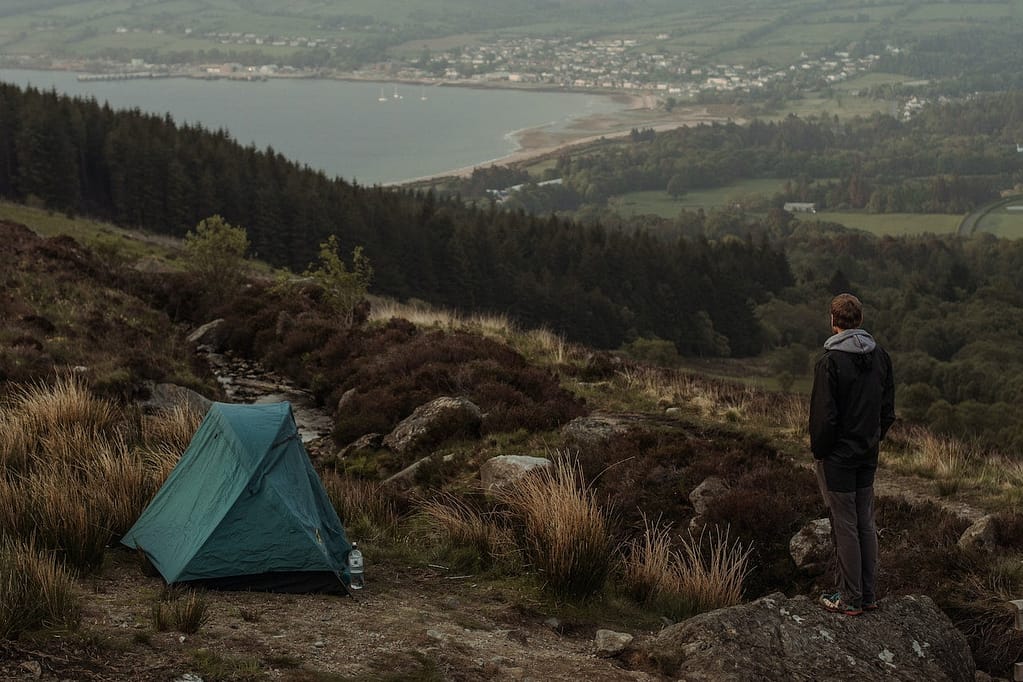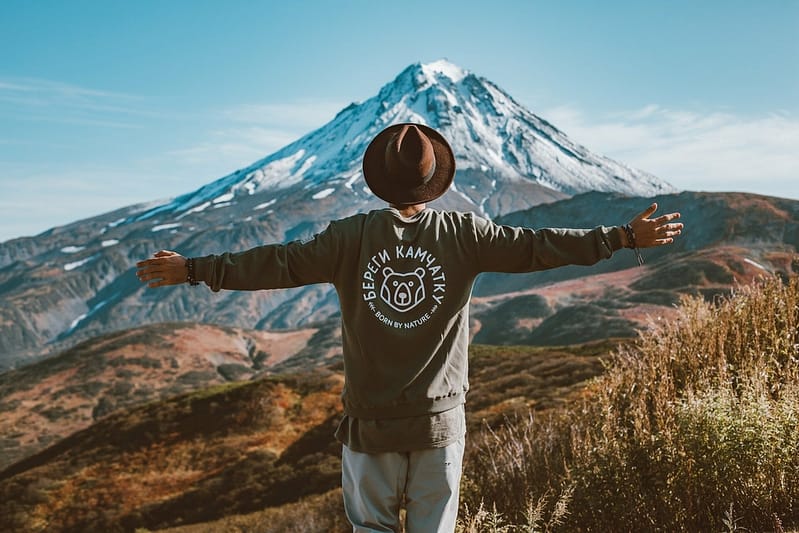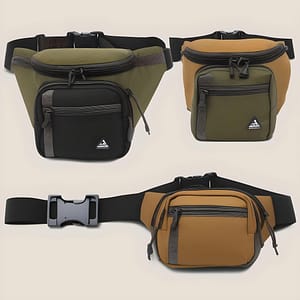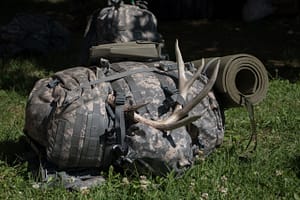In the mainstream outdoor recreation camping solo is not common. Hiking, glamping, camping with your partner and of course, camping with the family, are much more common. But for me, the most unique experience, even if the challenging, was camping solo. A few days without talking to any person except people I saw at the beginning of the camping and at the end of the camping, was a humbling experience.
Camping alone a fulfilling experience, but proper planning and preparation are crucial. In this guide, we’ll walk you through everything you need to know about choosing the right location, gathering essential gear, ensuring safety, setting up your campsite, cooking delicious meals, handling emergencies and practicing good etiquette.
Choosing the Right Location

Consider your skill level and experience when choosing the right location for solo camping. If you have limited experience, opt for a camping destination that offers beginner-friendly trails and well-marked paths. Research different destinations to find one that aligns with your hiking preferences and interests. When evaluating safety and accessibility, ensure the chosen location has nearby amenities and is easily reachable in case of emergencies. Plan accordingly by packing appropriate gear such as a sturdy tent to protect against unpredictable weather conditions.
Consider your skill level and experience
Assessing your camping skills and abilities is crucial before embarking on a solo camping adventure. Reflect on past camping experiences to gain insights into what worked well and what didn’t. Identify areas for improvement, such as hiking stamina or tent pitching skills.
Considerations:
- Evaluate your experience level in camping and outdoor activities.
- Reflect on previous trips to learn from successes and challenges.
- Identify areas for improvement, such as navigation skills or knowledge of gear maintenance.
Research different camping destinations
Researching different camping destinations is an essential step in planning your solo camping adventure. Here are some key points to consider:
- Exploring national parks and wilderness areas:
- These locations offer stunning natural landscapes and ample opportunities for hiking and exploring.
- Investigating campgrounds near you:
- Look for campgrounds that provide the amenities you need, such as tent sites, restrooms, and access to hiking trails.
- Reading reviews and recommendations from experienced solo campers:
- Gain insights from those who have already explored the area, ensuring a more informed decision on where to pitch your tent.
By thoroughly researching different camping destinations, you can find the perfect spot that aligns with your preferences and ensures a memorable solo camping experience.
Evaluate the safety and accessibility of the location
Checking weather conditions in advance, considering terrain difficulty and elevation changes, and investigating local wildlife activity are crucial steps to evaluate the safety and accessibility of a camping location. Before embarking on your solo camping adventure, it is important to be aware of the weather forecast for the area you plan to visit. Extreme temperatures or severe storms can make your experience hazardous or uncomfortable. Additionally, assessing the terrain difficulty and elevation changes will help you determine if you have the necessary hiking skills and physical fitness level to tackle the trails in that particular location. Finally, investigating local wildlife activity will enable you to take precautions against encounters with potentially dangerous animals while ensuring a safer camping experience overall.
Gathering the Essential Camping Gear

Invest in a quality tent and sleeping bag
Investing in a quality tent and sleeping bag is essential for solo camping. A sturdy, weather-resistant tent will provide shelter and protection from the elements, while a comfortable sleeping bag will ensure you get a good night’s sleep. Look for lightweight options that are easy to set up and pack away.
Consider the size and weight of your tent to ensure it is easy to carry on solo camping trips. Look for a tent with good ventilation to keep you comfortable in various weather conditions. Opt for a sleeping bag suitable for the expected weather, ensuring you stay warm or cool throughout the night.
Pack appropriate clothing and footwear
Packing appropriate clothing and footwear is crucial when preparing for a solo camping adventure, so bring layers to accommodate changing temperatures. Dress in layers to easily adjust your comfort level as the weather can be unpredictable. Choose moisture-wicking fabrics that dry quickly if they get wet, and don’t forget sturdy, supportive footwear suitable for hiking on different terrains – blisters can turn your trip into an uncomfortable experience. Layering options such as thermal tops, lightweight jackets, and versatile pants will ensure you are prepared for any temperature changes that may occur during your solo camping adventure.
Include rain gear for unexpected weather. Don’t let a sudden downpour ruin your trip! Be sure to pack a waterproof jacket or poncho, along with waterproof pants or leggings, to keep yourself dry in case of rain showers. Additionally, consider bringing an umbrella or a waterproof cover for your backpack to protect your belongings from getting wet.
Ensure you have sturdy hiking boots or shoes. As you venture into the wilderness on foot, having reliable footwear is essential for both comfort and safety. Invest in durable hiking boots or shoes that provide good ankle support and have non-slip soles to navigate uneven terrain with ease.
Bring cooking equipment and food supplies
Pack a portable camping stove or grill for convenient cooking while solo camping. Along with the stove, remember to bring utensils, pots, and pans for preparing meals. Plan your meals ahead of time and pack non-perishable foods that are easy to store and prepare during your adventure.
Planning and Packing for Safety
Informing someone about your camping plans and duration is essential for safety. Make sure to provide a detailed itinerary, including the location, dates, and expected return date. This way, if anything goes wrong or you fail to check-in as planned, authorities will have crucial information to assist in locating you.
Carrying a well-stocked first aid kit and necessary medications can be lifesaving during solo camping trips. Include essentials like bandages, antiseptic ointment, painkillers, insect repellent, and any prescription medications you require. Being prepared with these supplies can help address minor injuries or illnesses promptly and prevent them from escalating.
Preparing for various weather conditions is vital when venturing into the wilderness alone. Check the forecast before heading out and pack appropriate clothing layers for warmth or protection against rain or sun exposure. Additionally, ensure your tent is sturdy enough to withstand potential wind gusts or heavy rainfall that may occur during your trip.
Inform someone about your camping plans and duration
Choosing a reliable emergency contact is crucial when informing someone about your camping plans and duration. Select someone who can be easily reached and is responsible enough to handle any potential emergencies on your behalf.
Sharing your itinerary with a trusted friend or family member ensures that someone knows exactly where you’ll be during your camping trip. Provide them with detailed information about the locations you plan to visit, including campsite names, hiking routes, and estimated times of arrival at each destination.
It’s essential to provide details on your expected return date when informing someone about your camping plans and duration. This allows them to have an idea of when they should expect you back and take appropriate action if they don’t hear from you by then.
Carry a first aid kit and necessary medications
Including bandages, antiseptic wipes, and pain relievers in your first aid kit is essential for any solo camping adventure. These items can help treat minor injuries and provide temporary relief from pain. Additionally, packing any prescription medications you require with clear instructions ensures that you have them readily available when needed. It’s also a good idea to consider carrying insect repellent and allergy medication if needed to protect yourself from bug bites or manage allergies while on your trip.
- Include bandages, antiseptic wipes, and pain relievers in your first aid kit
- Pack any prescription medications with clear instructions
- Consider carrying insect repellent and allergy medication if needed
Prepare for various weather conditions
Prepare for Various Weather Conditions
Before setting off on your solo camping adventure, it is crucial to check the local weather forecast. This will help you anticipate any potential changes in the weather and plan accordingly. Along with that, ensure you pack appropriate clothing layers that can cater to both warm and cold temperatures. This way, you’ll be prepared for sudden shifts in weather conditions during your trip. Additionally, don’t forget to bring rain gear such as waterproof jackets or tents to protect yourself from unexpected showers.
- Check the local weather forecast before departure
- Pack appropriate clothing layers for both warm and cold temperatures
- Bring rain gear such as waterproof jackets or tents
Mastering Campsite Set-Up and Maintenance

Choose a flat and level spot to set up your tent, away from any potential hazards or obstacles. Clear the area of rocks, branches, and debris to ensure a comfortable sleeping surface. Consider the direction of sunlight and wind when selecting your campsite for optimal comfort.
When setting up your campfire, choose an appropriate location that is at least 15 feet away from tents and other flammable materials. Clear the area around the fire pit of leaves and other combustible materials. Always have water or sand nearby to extinguish the fire completely before leaving.
Respect nature by practicing Leave No Trace principles during your camping trip. Pack out all trash you generate, including food scraps and toilet paper. Minimize impact on vegetation by staying on designated trails or durable surfaces. Respect wildlife by observing them from a distance without feeding or disturbing them.
Choose the right spot for your tent

Choose the perfect spot for your tent to ensure a comfortable and safe camping experience. Take into consideration the terrain and slope of the area, look for natural windbreaks, and check for potential hazards.
Consider the following when choosing your campsite:
- Terrain and slope:
- Find a level area to pitch your tent that will provide comfort while sleeping.
- Natural windbreaks:
- Look for trees or large rocks that can offer protection from strong winds.
- Potential hazards:
- Check for fallen branches, uneven ground, or any other potential dangers in the vicinity of your chosen spot.
Remember, selecting an appropriate location is crucial to enjoying a successful solo camping trip.
Set up a proper campfire
Find a designated fire pit or clear an area by removing any debris and creating a safe distance from trees and bushes. This will help prevent the spread of flames and ensure that your campfire is contained. Gather dry wood and kindling, making sure they are not only easily ignitable but also sustainable for a long-lasting fire. Follow safety precautions such as having a bucket of water nearby, never leaving the fire unattended, and fully extinguishing it before leaving the campsite to minimize any potential risks or accidents.
Practice Leave No Trace principles
Pack out all trash and waste to ensure the preservation of the natural environment. Leave no trace behind, taking responsibility for your own garbage and disposing of it properly. This includes any packaging, food scraps, or personal items that you brought with you on your solo camping adventure.
Minimize disturbance to flora and fauna by being mindful of your surroundings. Avoid trampling on delicate plants or disturbing wildlife habitats. Be aware of nesting areas or dens and give them a wide berth to prevent any harm or disruption.
Avoid damaging vegetation or trees by not cutting branches or damaging their bark. Respect the natural beauty around you by refraining from carving initials into trees or leaving marks that will take years to heal. Remember, when practicing Leave No Trace principles, leave nature exactly as you found it – untouched and pristine
Cooking and Food Safety Tips
- When solo camping, it’s crucial to plan and prep your meals in advance. This ensures that you have enough food for the duration of your adventure and reduces the risk of foodborne illnesses.
- To prevent wildlife encounters, store your food securely. Use bear-resistant containers or hang food bags from high tree branches at least 10 feet off the ground and 4 feet away from the trunk.
- Opt for lightweight and non-perishable food options when packing for solo camping. Think dried fruits, nuts, energy bars, dehydrated meals, and instant soups that require minimal preparation but still provide necessary nutrients.
Plan and prep your meals in advance
Create a customized meal plan tailored to your dietary needs before embarking on your solo camping adventure. This will ensure that you have all the necessary ingredients and avoid any last-minute stress. Additionally, take some time to prepare and portion out ingredients at home, saving valuable time at the campsite. By doing so, you can focus on enjoying nature rather than spending excessive time cooking and cleaning up.
Consider selecting easy-to-cook meals that require minimal equipment while planning your menu for solo camping. Opting for recipes with fewer steps and simple cooking techniques will make your outdoor cooking experience hassle-free. Incorporate one-pot meals or foil packet recipes into your meal plan as they are convenient options that can be easily prepared over a campfire or portable stove, minimizing the need for extensive cookware and utensils.
Store food securely to prevent wildlife encounters
- Use bear-resistant containers or hang food in a tree away from the campsite
- Keep all food items sealed tightly in waterproof bags or containers
- Avoid bringing strong-smelling foods that may attract animals.
Pack lightweight and non-perishable food options
Choose dehydrated meals that can be easily rehydrated with hot water at the campsite. These meals are lightweight and convenient, making them perfect for solo camping trips. Additionally, opt for lightweight snacks like trail mix, energy bars, and dried fruits to keep you fueled throughout your adventure. Lastly, don’t forget to pack canned goods with pull-tab lids as they provide quick and convenient meal options without the need for a can opener.
Dealing with Emergency Situations
In the wilderness, wildlife encounters can be unpredictable and potentially dangerous. To handle these situations, it is crucial to stay calm and avoid panicking. Make noise or use bear spray to deter aggressive animals, while maintaining a safe distance. If an encounter escalates, back away slowly without turning your back on the animal.
When camping alone, preparing for medical emergencies and injuries is essential. Carry a well-stocked first aid kit that includes essentials like bandages, antiseptic ointment, pain relievers, and any necessary prescription medication. Familiarize yourself with basic first aid techniques before embarking on your solo adventure.
Creating an emergency communication plan will help ensure prompt assistance if needed during solo camping trips. Inform trusted family or friends of your itinerary ahead of time and establish regular check-in times with them throughout your trip using satellite devices or other reliable means of communication.
Know how to handle wildlife encounters
Identify the common wildlife species in your camping area to better understand their behavior and habits. Research online or consult local authorities for information on the types of animals you may encounter. This knowledge will help you anticipate potential encounters and take necessary precautions.
Ensure food is stored safely to minimize attracting wildlife. Use bear-resistant containers or hang food from a tree branch at least 10 feet off the ground and four feet away from any trunk or limb. Additionally, dispose of waste properly by using designated trash bins or packing it out with you. Properly managing food and waste reduces the risk of wildlife approaching your campsite looking for an easy meal.
Prepare for medical emergencies and injuries
Pack a well-stocked first aid kit to ensure you’re prepared for any medical emergencies or injuries while solo camping. Include essentials like bandages, antiseptic wipes, pain relievers, and adhesive tape. Additionally, learn basic first aid techniques for common camping injuries such as cuts, burns, sprains, and insect bites to effectively handle any situation that arises.
Research nearby medical facilities and emergency services before heading out on your solo camping adventure. Know the location of the nearest hospital or urgent care center in case of more serious emergencies. Familiarize yourself with local emergency numbers so you can quickly call for help if needed. Being aware of these resources will provide peace of mind knowing that help is readily available when necessary.
Create an emergency communication plan
Share your itinerary with a trusted friend or family member. It’s important to let someone know where you’ll be and when you expect to return. This way, if something goes wrong, they can notify authorities and provide them with crucial information about your location.
Invest in a reliable communication device, such as a satellite phone or locator beacon. These devices can ensure that you have access to emergency services even in areas with no cell reception. They provide peace of mind knowing that help is just a call away.
Familiarize yourself with local emergency contact numbers. Each area may have specific numbers for police, medical services, and search and rescue teams. Knowing these numbers beforehand will save valuable time during an emergency situation.
Solo Camping Etiquette and Mindset

Respect nature and leave the campsite as you found it. Dispose of waste properly, including trash and human waste. Follow Leave No Trace principles to minimize your impact on the environment.
Be mindful of noise and solitude. Keep voices low, avoid loud music or disturbances that may disrupt wildlife or other campers nearby. Cherish the serenity of being alone in nature.
Stay positive and embrace the solo experience. Embrace solitude as an opportunity for self-reflection and personal growth. Stay open-minded, be adaptable to unexpected situations, and enjoy the freedom that comes with solo camping adventures
Respect nature and leave the campsite as you found it
Proper waste disposal is crucial when camping alone. By using designated trash bins or packing out your garbage, you can minimize the impact on the environment and keep the campsite clean. Leave no trace principles should guide your actions, ensuring that you leave behind only footprints and take away memories. Additionally, as a responsible camper, it’s important to exercise caution when using fire by following local regulations and leaving fire rings undisturbed.
- Dispose of waste properly
- Follow leave no trace principles
- Be cautious with fire
Be mindful of noise and solitude
Quiet hours are crucial for maintaining a peaceful camping experience. Avoid engaging in disruptive activities during these designated times to respect the tranquility of the environment. Additionally, be considerate of neighboring campsites by keeping noise levels to a minimum and being mindful of how your actions may affect others seeking solitude in nature.
Stay positive and embrace the solo experience
Developing a positive mindset is essential when embarking on a solo camping adventure. Embrace the solitude and take this opportunity to connect with nature on a deeper level. Engage in activities such as hiking, fishing, or stargazing to fully immerse yourself in the experience and appreciate the beauty of your surroundings. Use this time alone for self-reflection and personal growth, allowing yourself to disconnect from the outside world and find inner peace amidst nature’s embrace.
In conclusion, practicing responsible and mindful solo camping is crucial for minimizing your impact on the environment and ensuring a positive experience for both yourself and others. By following the principles of minimizing noise and solitude, respecting nature, properly disposing of waste, and being cautious with fire, you can enjoy a peaceful and fulfilling solo camping adventure while preserving the beauty and serenity of nature. Embrace the solitude, stay positive, and immerse yourself in the wonders of the natural world to truly make the most of your solo camping experience.





